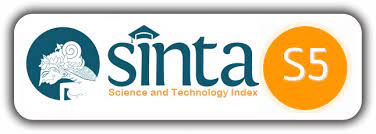Permainan Musik Drumband Sebagai Stimulasi Sensitivitas Irama Anak Usia 5-6 Tahun
Abstract
Sensitivitas irama merupakan kemampuan mengenali, mengikuti, dan mengekspresikan pola ritmis dalam musik, berperan penting dalam perkembangan kognitif, motorik, dan sosial-emosional anak usia dini. Penelitian ini bertujuan menganalisis pengaruh permainan musik drumband terhadap sensitivitas irama anak usia 5–6 tahun di RA Al-Hidayah. Metode kuasi eksperimen dengan desain non-equivalent control group digunakan pada 15 anak kelompok eksperimen dan 15 anak kelompok kontrol. Perlakuan berupa empat sesi permainan drumband berdurasi 30 menit, melibatkan variasi ketukan, tempo, dan penggunaan alat musik perkusi. Instrumen observasi mencakup enam indikator sensitivitas irama dengan skala Likert 1–4. Analisis menggunakan uji Mann–Whitney U menunjukkan peningkatan signifikan pada kelompok eksperimen (p < 0,05). Hasil ini sejalan dengan teori Campbell & Scott-Kassner dan Gordon tentang pengalaman musikal terstruktur yang memperkuat audiation dan keterampilan ritmis. Temuan mendukung integrasi kegiatan drumband dalam pembelajaran PAUD sebagai stimulasi musikal yang menyenangkan dan holistik.
References
Campbell, P. S., & Scott-Kassner, C. (2019). Music in childhood: From preschool through the elementary grades. Cengage Learning.
Costa-Giomi, E. (2014). Music instruction and children’s intellectual development: The educational context of music participation. Music Education Research, 16(3), 269–282.
Degé, F., & Schwarzer, G. (2011). The effect of a music program on phonological awareness in preschoolers. Frontiers in Psychology, 2, 124.
Flohr, J. W., & Persellin, D. C. (2011). Musical experiences and young children’s development. Music Educators Journal, 98(2), 28–33.
Forgeard, M., Winner, E., Norton, A., & Schlaug, G. (2008). Practicing a musical instrument in childhood is associated with enhanced verbal ability and nonverbal reasoning. PLOS ONE, 3(10), e3566.
Gordon, E. E. (2012). Learning sequences in music: Skill, content, and patterns. GIA Publications.
Habibi, A., Ilari, B., Crimi, K., Metke, M., Kaplan, J. T., Joshi, A. A., ... & Damasio, H. (2018). An equal start: Absence of group differences in cognitive, social, and neural measures prior to music or sports training in children. Frontiers in Human Neuroscience, 12, 404.
Hallam, S. (2015). The power of music: A research synthesis of the impact of actively making music on the intellectual, social, and personal development of children and young people. International Journal of Music Education, 33(2), 285–305.
Johansson, K. (2020). Rhythm and timing skills in young children: Effects of a structured music program. Journal of Research in Music Education, 68(1), 45–61.
Kim, M., & Schallert, D. L. (2016). The role of rhythm in young children’s executive function. Early Childhood Research Quarterly, 36, 1–12.
Kraus, N., & Chandrasekaran, B. (2010). Music training for the development of auditory skills. Nature Reviews Neuroscience, 11(8), 599–605.
Lima, C. F., & Castro, S. L. (2011). Speaking to the trained ear: Musical expertise enhances the recognition of emotions in speech prosody. Emotion, 11(5), 1021–1031.
Moreno, S., & Bidelman, G. M. (2014). Examining neural plasticity and cognitive benefit through the unique lens of musical training. Hearing Research, 308, 84–97.
Paananen, P. (2006). The development of musical abilities in preschool children. Early Child Development and Care, 176(7), 735–746.
Patel, A. D. (2011). Why would musical training benefit the brain? The cognitive neuroscience of music and language. Frontiers in Psychology, 2, 142.
Resa, R. (2021). Pengaruh kegiatan ansambel musik terhadap perkembangan ritmis anak usia dini. Jurnal Pendidikan Anak Usia Dini, 10(2), 123–135.
Rickard, N. S., Bambrick, C. J., & Gill, A. (2012). Absence of widespread psychosocial and cognitive effects of school-based music instruction in 10–13-year-old students. International Journal of Music Education, 30(1), 57–78.
Ritchie, S. J., & Tucker-Drob, E. M. (2018). How much does education improve intelligence? Psychological Science, 29(8), 1358–1369.
Sala, G., & Gobet, F. (2017). When the music’s over: Does music skill transfer to children’s and young adolescents’ cognitive and academic skills? Educational Research Review, 20, 55–67.
Schellenberg, E. G. (2004). Music lessons enhance IQ. Psychological Science, 15(8), 511–514.
Schellenberg, E. G. (2011). Examining the association between music lessons and intelligence. British Journal of Psychology, 102(3), 283–302.
Slater, J., Tierney, A., & Kraus, N. (2013). At-risk elementary school children with one year of classroom music instruction are better at keeping a beat. PLOS ONE, 8(10), e77250.
Standley, J. M. (2008). Does music instruction help children learn to read? Update: Applications of Research in Music Education, 27(1), 17–32.
Swaminathan, S., & Schellenberg, E. G. (2015). Music training and cognitive abilities: Associations, causes, and consequences. Psychological Science, 26(7), 1383–1389.
Tierney, A., & Kraus, N. (2013). Music training for the development of reading skills. Progress in Brain Research, 207, 209–241.
Trainor, L. J., & Corrigall, K. A. (2010). Music acquisition and effects of musical experience. The Neurosciences and Music IV: Learning and Memory, 1169(1), 89–92.
Trehub, S. E., & Trainor, L. J. (1998). Singing to infants: Lullabies and play songs. Advances in Infancy Research, 12, 43–78.
Volk, T. M. (2004). Music, education, and multiculturalism: Foundations and principles. Oxford University Press.
Welch, G. F., Himonides, E., Saunders, J., Papageorgi, I., & Sarazin, M. (2014). Singing and social inclusion. Frontiers in Psychology, 5, 803.
Williams, K. E., & Barrett, M. S. (2018). The development of a musical self-concept in young children. Psychology of Music, 46(2), 155–170.
Wong, P. C. M., Skoe, E., Russo, N. M., Dees, T., & Kraus, N. (2007). Musical experience shapes human brainstem encoding of linguistic pitch patterns. Nature Neuroscience, 10(4), 420–422.
Yoo, H., & Kim, J. (2018). The effects of rhythm training on children’s attention and working memory. Journal of Music Therapy, 55(2), 223–245.
Zatorre, R. J. (2013). Predispositions and plasticity in music and speech learning: Neural correlates and implications. Science, 342(6158), 585–589.
Zuk, J., Benjamin, C., Kenyon, A., & Gaab, N. (2014). Behavioral and neural correlates of executive functioning in musicians and non-musicians. PLOS ONE, 9(6), e99868.







.png)





